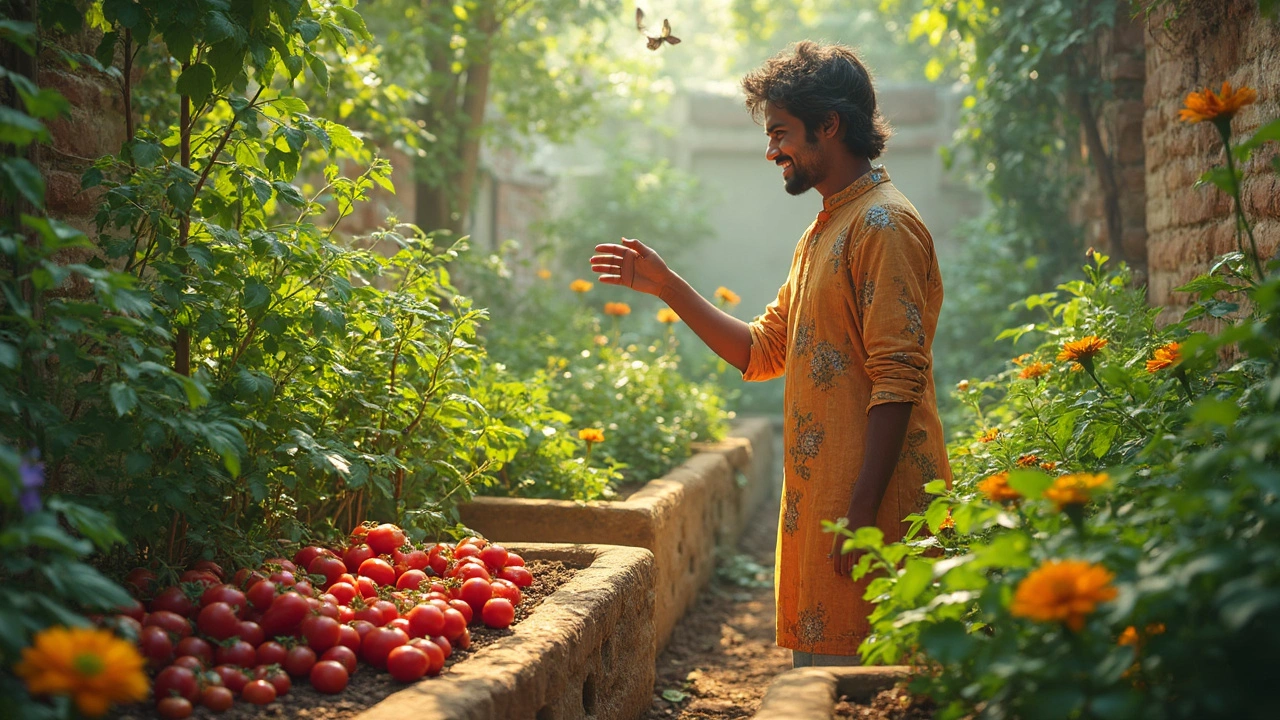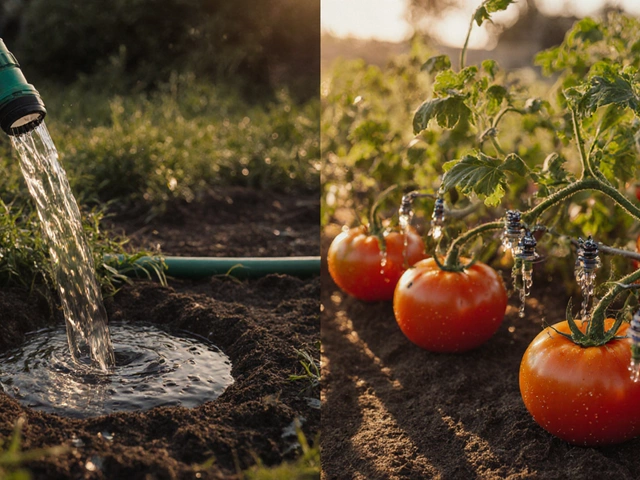Ever wondered why some garden beds look fuller and healthier than others? A lot of it comes down to which veggies cozy up next to each other. There’s more to it than just tossing seeds into random spots. Plants actually help or hurt each other depending on who’s nearby. This is called companion planting, and it isn't some new fad—people have been doing it for ages to cut down on bugs, disease, and wasted space.
Think of it like picking a good roommate. Some vegetables are great friends, sharing nutrients and even keeping pests away. Others, well, they’re better off not sharing the same patch of dirt. You want combinations that just work, like tomatoes and basil or carrots and onions. When you get it right, you end up with stronger plants, less need for chemicals, and a whole lot less hassle.
- Why Companion Planting Works
- Classic Vegetable Duos That Thrive
- Common Mistakes to Avoid
- Quick Tips for Happy Veggie Neighbors
Why Companion Planting Works
Companion planting isn’t some magic trick. Plants really do help each other—and sometimes get in each other’s way. When you put friendly veggies together, they can improve each other’s growth, ward off harmful bugs, and even enhance flavor. It all comes down to the stuff going on above and below ground: roots, leaves, and how each plant affects the space around it.
Some veggies actually release chemicals that keep pests away, which means you don’t have to reach for sprays as often. Take marigolds next to tomatoes—they send out a scent that nematodes and other bugs find pretty nasty. Beans and peas are good neighbors for many plants because they add nitrogen to the soil as they grow, giving things like lettuce and spinach a steady supply of nutrients without fancy fertilizers.
Mixing up your companion planting choices also cuts down on disease setting up shop in your beds. When you plant just one thing in a big area, pests and diseases that like that crop can take over fast. But mixing things up confuses those pests, making it harder for them to move from plant to plant.
- Tomatoes and basil: basil helps keep tomato hornworms in check.
- Carrots and onions: onions hide carrots from carrot flies, and vice versa.
- Corn, beans, and squash (the classic "Three Sisters"): corn gives beans a pole, beans feed the soil, squash spreads out to keep the weeds down.
If you want numbers, a 2014 study from Iowa State University found that gardens with mixed veggies and companion flowers had 35% fewer pest problems compared to single-crop rows. Less work for you, and healthier plants for the whole season.
| Benefit | Example |
|---|---|
| Pest control | Marigolds reduce root-knot nematodes by up to 90% |
| Better soil | Beans fix nitrogen, helping leafy veggies grow bigger |
| Increased yield | Corn and beans together often yield 15% more than solo crops |
So, pairing veggies isn’t just old gardening lore. Science and experience both say the right combos pay off, especially when you’re aiming for a low-waste, high-yield garden.
Classic Vegetable Duos That Thrive
Some veggie pairs just click, and they’re backed up by folks who’ve gardened for decades. Let’s talk about the famous combos and why they’re more than just old wives’ tales—they actually work for real reasons.
- Tomatoes & Basil: Basil helps keep pesky bugs like aphids and hornworms off your tomatoes. Plus, some studies suggest tomatoes taste better when basil grows close by. This pairing is all over Italian gardens for a reason.
- Carrots & Onions: Onions send out a strong smell that confuses carrot fly bugs, while carrots go the other way and make life tougher for onion flies. You’re not just saving space here; you’re building a bug-busting tag team.
- Corn, Beans & Squash (The Three Sisters): This old Native American method is pure genius. Corn gives beans something to climb on, beans fix nitrogen in the soil for everyone, and squash sprawls out to keep weeds down with its big leaves. If you want a natural way to boost yields without chemicals, try this trio.
- Radishes & Cucumbers: Radishes pop up fast and break up the soil, which helps cucumbers send deeper roots. They’re also known to scare off cucumber beetles.
- Lettuce & Carrots: Lettuce grows quick and shades out weeds while carrots take their sweet time getting started. Planting lettuce in carrot rows lets you have an early harvest and clear spots for carrots to fill in later.
Here’s a quick look comparing some of the more popular pairs and what each one brings to the soil or keeps away:
| Vegetable Pair | Main Benefit | Pest Control | Other Perks |
|---|---|---|---|
| Tomato & Basil | Better flavor, healthier growth | Aphids, hornworms | Basil may repel mosquitoes too |
| Carrot & Onion | Pest confusion, fewer carrot flies | Carrot fly, onion fly | Save space, simple weed control |
| Corn, Beans & Squash | Mutual support, improved soil | Less need for fertilizer | Natural weed barrier |
| Radish & Cucumber | Better soil, early pest warning | Cucumber beetles | Loose soil for roots |
| Lettuce & Carrot | Maxed out bed space | Minimal pests | Staggered harvests |
Don’t forget, not every plant combination is perfect. But these vegetables duos have real history and science behind their success. If you’re just starting with companion planting, picking a couple of these is a safe bet to see real garden improvement by late summer.

Common Mistakes to Avoid
It’s easy to mess up companion planting, especially if you’re new to the game. One classic mistake is thinking all vegetables are friendly to each other. Trust me, some plants just don’t get along. For example, don’t put onions next to beans or peas—they actually slow each other down. Beans prefer to do their own thing without the alliums (like garlic, leeks, or onions) crowding them.
Another big slip-up is cramming plants too close. Even with companion planting, veggies still need breathing room. Overpacking a bed means roots compete for water and nutrients, and air can’t flow well. That’s just asking for mildew or rot, especially in wet weather. Always check spacing on seed packets or plant tags—following those recommendations pays off.
Be careful with climbers like pole beans. If they shade out sun-loving crops like peppers or tomatoes, you’ll end up with sad, stunted growth. Make sure the vines go on the north or east side of your bed so they don’t block out the light your vegetables need most.
- Don’t mix aggressive spreaders, like mint, with almost anything—they’ll take over fast. Plant them in pots if you want them nearby.
- Avoid random pairings. Check a trusted companion planting chart or reliable book before you decide on garden neighbors.
- Watch for pests that like certain combos. For example, planting potatoes and tomatoes together might make it easier for blight to jump from one plant to another.
Bottom line? Plan your pairings, give everything space, and keep an eye on the sunlight. Your garden will thank you.
Quick Tips for Happy Veggie Neighbors
Want your vegetable garden to grow like a champ? Pairing the right veggies makes a real difference. Here’s how to keep your plants—not to mention your harvest—strong and happy.
- Companion planting works best when you actually plan it out on paper first. Sketch your garden beds and fill in what goes where, based on known good pairings (like beans with corn, lettuce with carrots, or tomatoes with basil and onions).
- Don’t crowd your plants together. Each veggie needs breathing room, even if its neighbor is a good match. Sticking with the right spacing helps air flow, which keeps fungus at bay.
- Watch the sun. Some combos are great for shading smaller, delicate plants. For example, plant tall corn on the north side and lower crops like radishes or lettuce below—they’ll get some cool shade during the hottest parts of the day.
- Mix strong-scented herbs like garlic, dill, and basil throughout your patch. These confuse pests and cut down on bugs that typically go after your veggies.
- Rotate your crops every year. Don’t plant the same combos in the same spot season after season. This way, you trap fewer pests and diseases in the soil.
- Avoid putting heavy feeders like tomatoes and broccoli side by side. They’ll compete for nutrients and usually end up underperforming. Pair nutrient-hungry veggies with beans or peas which can actually boost nitrogen in the soil.
- Keep a simple chart on hand of combos that work and those that don’t. Tape it in your garden shed—trust me, this saves time when you’re planting in spring with dirt under your nails and Max barking for a stick throw.
Set yourself up for a straightforward, low-stress, and productive season just by playing matchmaker with your veggies. Small details matter, but once you nail these, it feels easy.





